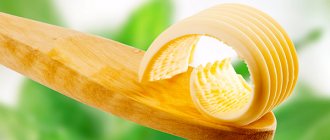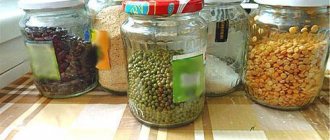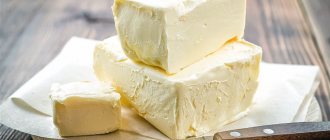Butter is a frequent guest in our kitchen. It is tasty and healthy if you choose a quality product and store it properly. To keep the oil fresh longer, it should be kept in the refrigerator or freezer. But there are situations when this is not possible. In this case, you can also extend the life of the product if you know some secrets. Let's talk in more detail about each storage method.
How to store in the refrigerator
Freezer storage rules
How to store without refrigeration
How to restore freshness to oil
Signs of quality oil
Shelf life according to GOST. What do they depend on?
The shelf life and storage conditions of fat and oil products are stipulated by the current GOST 32261-2013 “Butter. Technical conditions". The shelf life of a product is determined by its type, technical characteristics of manufacture and storage mode.
Oil is divided into 2 types:
- sweet creamy;
- sour cream.
Each category additionally includes a salted and unsalted variety. The difference between them is in the initial components that are used in manufacturing. Sweet is made from pure cream, and sour is made with the addition of lactic acid bacteria.
The product is divided into 3 types according to the amount of milk fat in the composition:
- Traditional butter with a fat content of 82.5%;
- Amateur – 80%;
- Peasant - 72.5%.
Oil products are classified as perishable. Because of this, their storage duration is short. The shelf life of butter according to GOST, depending on packaging and temperature conditions, is indicated in the table:
Note:
The shelf life of butter produced during the grazing period, regardless of the type and quantity of milk fat packaged in foil, is 270 days. Provided that the temperature standards (not higher than -18 ° C) and humidity (70-90%) are met.
How to store at home: conditions, place, container, timing
How long butter is stored in the refrigerator does not depend on the production method. Both home and factory products have the same terms, which are determined by packaging and storage location.
At home, it is recommended to keep it in the refrigerator at a temperature of 0 to 6 °C in the following containers:
- In packaging from the manufacturer. If the factory wrapper is not transparent, then the product can be stored for the time indicated on it without changing to an oil can or foil.
- In an oil can, a tightly closed container made of opaque plastic. An oil dish is a recommended container for storing the product in the refrigerator. There is an important criterion - it must be opaque and covered with a lid. Such packaging will prevent exposure to light and the absorption of specific odors. The shelf life of butter under such conditions is 20 days.
- In foil, the shelf life is 21 days.
- In parchment paper. Butter wrapped in two layers of paper can be stored in the refrigerator for 10 days. Preservation of appearance, taste, and safety for food consumption is guaranteed.
You can increase the storage time by placing the product on a shelf with the lowest temperature. It is forbidden to put it in the door, as there are constant changes in degrees due to its opening and closing.
Note to the hostess
There is no need to store the oil and fat product in a plastic bag. Such containers contribute to the loss of taste.
The best option is to choose an oiler made of porcelain and stainless metal. Plastic products are bad because they are difficult to clean and quickly absorb odors, which are difficult to deal with.
Signs of a spoiled product
If the butter begins to spoil, it is easy to notice. First of all, the color will change: the product will acquire a yellowish tint. Smell is another indicator of freshness. Spoiled oil smells damp. A stale product tastes bitter.
Substandard oil is dangerous for consumption because pathogenic microorganisms develop in it as a result of oxidation processes. If a spoiled product enters the human gastrointestinal tract, it can cause severe poisoning.
Can butter be stored in the freezer?
The product can be stored for a long time in a freezer. This becomes especially relevant when it is purchased or made with your own hands in large quantities for stock.
A freezer with a temperature of -24 to -18 °C is optimal.
How long butter is stored in the freezer depends on its type:
- Salted food will last up to 1 year under the above conditions, and 9 months at -12 °C.
- The usual one will retain its properties for 5 and 3 months, respectively.
Next, the product loses its taste and becomes saturated with foreign odors.
Tip of the day
Due to the fact that natural butter freezes at sub-zero temperatures, before sending it to the freezer, it is necessary to divide it into portions and wrap it in foil or parchment paper for ease of further use.
Bakery
Bread, cookies, cakes, pies, whatever! Your freezer can handle all of these products. Freezing is a great way to prepare for a party ahead of time or stash away extra treats. Once cooled, wrap each cookie in plastic wrap and place in a vacuum sealed container. This way they can be stored for up to a month. Uncut cakes or brownies can also be wrapped in film and placed in the freezer for three months, and they need to be thawed at room temperature. Store-bought bread or muffins should be cooled in the refrigerator without opening the packaging, and then transferred to the freezer, where they can stay for up to two months. You can use the microwave for quick defrosting. You can also freeze the raw dough and then quickly defrost it to bake something.
Storage without refrigeration
It is possible to store the product without refrigeration for a long time. To do this, you need to prepare it correctly.
The first method will require enamel or glass containers, parchment, and salt.
- The product is divided into parts and wrapped in parchment paper.
- The briquettes are placed in a pan, into which a brine solution is then poured (25 g of salt per 1 liter of drinking water).
- Portions of oil are pressed down, for example, using a massive plate, so that they do not float to the surface.
- Cover the pan with a lid and put it in a cool, dark place.
You can also place the oil, divided into parts, into a clean cloth previously soaked in table vinegar. Place in a cool, dark place. It is important that there is no exposure to sunlight.
Learn how to properly melt butter for storage and how to store it later.
The methods will preserve the freshness and taste of the product for several weeks at a relative humidity of no more than 90%. Without special preparation, butter can be stored at room temperature without exposure to ultraviolet rays for one week.
Sunlight accelerates the deterioration of the product: the nutritional value decreases, yellowing occurs, the oil turns sour
If suddenly the product is exposed to direct sunlight and turns yellow, the situation can be saved. You need to do the following:
- Remove the top yellowed layer.
- Place the rest on a heated frying pan. Wait until the butter is completely melted.
- Remove the top substance and dispose of the sediment.
Do you know that…
Butter contains about 20 essential fatty acids, vitamins A, D, E, K. Under the influence of high temperatures and UV rays, substances oxidize and their beneficial qualities disappear.
Note to the hostess
It so happened that they didn’t pay attention and left the butter on the table. As a result, under the influence of sunlight, it turned yellow on top. But all is not lost - the damaged piece can still be saved. In this situation, do this:
- Carefully cut off the top layer of oil that has turned yellow.
- The rest is placed in the pan. Heat it up and wait for the butter to melt.
- When the oil boils, add 3 slices of fresh apple.
- After a minute, remove the pan and leave the oil to cool. Remove the apple pieces.
- When the oil has cooled, you need to put it in an oil dish and keep it out of the sun's rays.
And finally, some tips on how to distinguish real oil from a surrogate:
Good oil has a light, whitish or slightly yellow tint.
Real oil has virtually no odor, and it melts in your mouth.
When cut, a frozen product will break off into pieces, but not crumble.
A natural creamy product, after taking it out of the refrigerator, will never have droplets of moisture on the surface.
If you put a piece of butter in a heated frying pan, it will melt slowly, without crackling or unpleasant odor.
Why is it worth buying domestic oil? We recommend watching this video.
Butter or spread – how to tell the difference?
Not every buyer knows the difference between an oil-like product and butter. Some do not notice the differences, others tend to consider the spread a “low-fat” creamy product. What is it really?
The basis for making butter is cream. Normalized milk in special production separators is divided into skim milk and high-fat cream. Next, the latter are whipped using oil presses, resulting in the formation of oil. Everything in it is natural - if food additives are included in the composition, then in extremely small quantities.
May additionally include:
- natural dye carotene (no more than 3 mg/kg) for color;
- vitamin preservatives (vitamin A no more than 10 ml/kg);
- vegetable dye annatto (not more than 10 mg/kg);
- bacterial starter;
- salt;
- drinking water.
Do you know that…
Butter can be called a product made from cream with a fat content of at least 72.5%. Products containing other components are automatically classified as spreads and margarines. This product is cheaper than the real thing.
The spread is based on 2 parts:
- Dairy: cream, milk, buttermilk.
- Vegetable: corn, sunflower, olive, coconut, palm and other types of oil.
By carefully studying the composition, you can understand whether it is a spread or an oil. Also, natural cream products have GOST R-52969. If there are different numbers on the packaging, this is a vegetable fat product or margarine, which are manufactured according to other GOST standards, which allow the inclusion of flavors, preservatives, and emulsifiers. Thanks to this, the shelf life of the spread can reach up to 100 days.
Since 2014, GOST has been introduced for an independent product - butter with fillers: chocolate, honey, herbs, seafood and meat products, berries, fruits, vegetables and their mixtures
The following ways to independently distinguish spread from butter are popular among housewives:
- Place in the freezer, after 10 minutes take it out and cut a piece of paper. If the product crumbles, then it is a quality product; if not, then this is a sign of a spread.
- Natural butter has a characteristic pleasant smell and a dull yellow color. Yellow and orange indicate the presence of dyes. To detect them for sure, you need to put a piece in 40% alcohol. Coloring of the liquid indicates the presence of dyes.
- Heat up the speed and add the product. The butter will quickly melt and sizzle, and a pleasant smell will be heard. The spread will gradually begin to melt, and the resulting “aroma” will cause the need to ventilate the kitchen.
But these methods are not always justified.
Expert comment:
“Manufacturers of oil substitutes and spreads are constantly improving technology. I have been identifying falsified oils in the laboratory for many years, but even I cannot determine the falsification at home.”
Secrets of preparing second courses
- Old chicken will cook faster if, after it has been cooked for 20-30 minutes, it is immersed in cold water for 5-6 minutes.
- When they want to fry a chicken so that it is covered with a golden brown crust, the bird is rubbed inside and outside with cut lemon, then smeared with thick sour cream or mayonnaise on top.
- Cutlets, schnitzels and steaks will be soft and tender if you brush them with a whipped mixture of vinegar and vegetable oil 2 hours before frying. Do not add egg yolk to the minced meat; it will make the cutlets dry. Well, when frying the cutlets, turn them over more often, then they will retain the meat juice.











